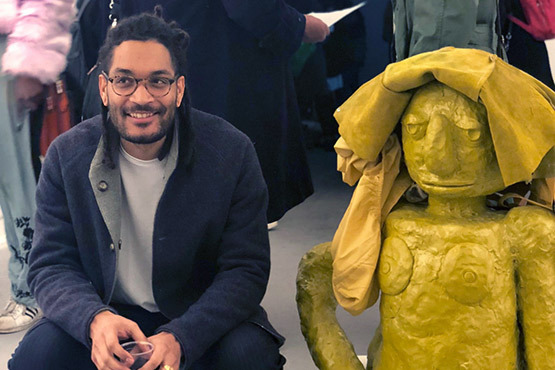
News . Feature Stories . Clotilde Jiménez: Stay connected
News
September 25, 2018
Clotilde Jiménez: Stay connected
Support for the business side of his career allows Printmaking alum to focus on creating.

Keep on learning. Hire good help. Balance business tasks with creative work as you’re planning your schedule. These themes emerged recently when we asked a handful of CIA’s many successful alumni what it takes to thrive as a self-employed artist. Clotilde Jiménez ’13 was one of them.
Tell us about your career.
I’ve recently earned my MFA at the Slade School of Fine Art and I’m represented by Mariane Ibrahim. My career is going very well and my studio practice is my only means of income. I’ve shown my work in various exhibitions and art fairs in Europe, Africa and the U.S. and I'm working with my art dealer to establish a healthy market for my work and also get into more institutional collections which is very important for emerging artists.
I’m fortunate enough to have found a studio space in London after graduation, and I keep busy by maintaining the momentum of making I had at the Slade.
As far as exhibitions go, I’m showing in a group show in LA with Zevitas Marcus until August 25, I’ve got a solo booth in EXPO Chicago with Mariane Ibrahim (Sept 26-30) titled Forbidden Fruiit, which is a kind of young graduate coming out presentation, and lastly and a group show at the Mennello Museum of American Art (Oct 19-Jan 13) titled Shifting Gaze: A Reconstruction of the Black and Hispanic Body in Contemporary Art.
Is this what the college version of you expected to be doing?
Since I graduated from CIA in 2013 I’ve always had a four-year plan for myself to achieve certain goals in my career. My plan was to take a couple of years between my BFA and MFA to grow as an independent artist outside of the confines of academia to prove to myself that I could do it. Then I wanted to go to grad school to reach the next level in my studio practice while learning what the art world had to offer and how it functioned in a big city. I had no idea I’d end up in London but it’s been a great place for me to learn about myself and what I’m doing—it’s given me perspective.
I always imagined myself gaining some traction with my art in a couple of decades. I never thought I’d have success in my twenties.
What is a typical day like for your now?
Well now that I’m not in school I have a lot of time on my hands to do with as I please. I try to set a structure for myself if I have shows coming up so that I’m working in my studio for blocks of time. Other than that, I get outside and breathe fresh air. In the past year, it’s been important for me to maintain my physical health as much as I do my artistic and intellectual abilities. So on a typical day I’m outside in the sun exercising and meeting friends later for an opening or theatre.
Do you consider “hustle” a necessary part of what you do?
I do believe hustling is essential for an emerging artist because we’re entrepreneurs and that’s the key ingredient in this business. I’ve done a fair bit of hustling since CIA. I think it’s important to understand what you want out of your career as an artist and go after that. Some of the things I did was taking the time to develop my art so that I had something realized to show the world. I also understood that social media was very powerful and that I needed to start following museums, artist, galleries and writers that I wanted to be a part of. I started tagging them in my work and making small connections that later grew to be very fruitful. I think also [it’s import to simply] be present and show up to exhibitions, not only because you like the artist or work but to be in that physical space. Conversations happen and you want to become memorable.
Do you spend much time on the business side of art?
My gallery is very good at taking care of a lot of these things. Ultimately what I look for in a business partner is a trustworthy person who can handle a lot of the technical things, because what I want to focus on is making the work. I used to promote myself in social media and in person, as I’ve said previously. I used to do all those things I said, but now I’m at a point where my gallery has set these things in motion and we maintain other things, like accounting, together.
The more I continue in my career the more people I meet that are working within the arts. Each show I have, exhibition I attend, lecture, etc., leads to more people who are potentially good contacts. It just kind of happens organically now.
Latest Headlines view all
-
April 02, 2024
Cleveland Institute of Art students partner with Progressive Art Collection to exhibit Ready, Set, Relay! -
March 04, 2024
Cleveland Institute of Art announces Curlee Raven Holton Inclusion Scholar Program -
November 06, 2023
Collision of art and artificial intelligence creates murky waters for artists, curators and educators
Questions?
For more information about this or other CIA news, contact us here.
Social Feed